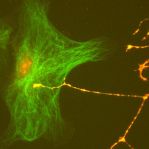
BSc (Aberdeen, 1991), PhD (London, 1994). Recipient of the College of Life Sciences and Medicine award for Excellence in Teaching, 2009 and of the Aberdeen University Students Association award for Most Accessible Lecturer (Champion for Disabilities), 201
Senior Lecturer
- About
-
- Email Address
- d.shewan@abdn.ac.uk
- Telephone Number
- +44 (0)1224 437381
- Office Address
Room 5.28, IMS.
- School/Department
- School of Medicine, Medical Sciences and Nutrition
Biography
Derryck Shewan graduated in Physiology from the University of Aberdeen in 1991, having gained a particular interest in the mechanisms of axon guidance. He undertook a studentship with Prof Jim Cohen at Guy’s Hospital Medical School, under the co-supervision of Prof Martin Berry, in the Developmental Neurobiology department, which has since evolved to the MRC Unit for Developmental Neurobiology at Hunt’s House, Kings College London. He gained his PhD in Anatomy and Cell Biology in 1994 having studied mechanisms of axon growth and regeneration, building up an appreciation of the changing nature of neuronal behaviour during development. In 1994 Dr Shewan was appointed a Research Fellow in Dr Cohen’s laboratory, which involved some time working with Dr Geneviève Rougon and her colleagues at the CNRS Faculté des Sciences de Luminy in Marseille. In 1997 he moved to the Department of Anatomy at the University of Cambridge as a Research Associate in Prof Christine Holt’s laboratory. Having spent 3 years studying the development of the visual system, Dr Shewan moved on in 2000 to the Department of Physiology at the University of Cambridge as a Research Associate in Professor James Fawcett’s laboratory. In 2001 he moved with Professor Fawcett’s group to he Cambridge Centre for Brain Repair. Dr Shewan was appointed Lecturer in Biomedical Sciences at the University of Aberdeen in 2003, and promoted to Senior Lecturer in 2006. He now forms part of the Aberdeen University Spinal Injury Research Group. He was afforded the College of Life Sciences and Medicine Award for Excellence in Teaching in 2009, nominated again in 2010, nominated for the Students Association award for Supporting Students in 2011 and afforded the Students Association award for most Accessible Lecturer (Champion for Disabilities) in 2016.
- Research
-
Research Overview
Dr Shewan is interested in the changing intracellular signalling mechanisms that accompany neuronal maturation. In particular, he focuses on the growth and regenerative capacities of embryonic and adult neurons in order to find differences that may help to explain why neurons of the central nervous system become incapable of regenerating after injury. A more detailed synopsis of Dr Shewan's work can be found at the Cell and Developmental Biology Research Theme at the University of Aberdeen.




- Teaching
-
Teaching Responsibilities
I am the co-ordinator of Biomedical Sciences Honours year research projects (BM4501, DB 4501, PA4501, PY4501 and SR4501).
Also at Level 4 I deliver lectures on axon guidance and contribute to course assessments on the Honours year core course on Advanced Molecules, Membranes and Cells (BM4004), as well as lecture on Sensory Systems and participate in the assessment of student seminars on Brain Function and Malfunction (AN4002).
At level 2 I present and demonstrate on Foundation Skills for Life Sciences (BI2005) and also tutor and act as Theme leader for 'Nervous System Diseases' on the Research Skills for Life Sciences course (BI2506). I deliver lectures on Sensory Systems on Physiology of Human Cells (BI20B2).
I co-ordinate the DevelopMental Theme for the Phase 1 MBChB Student Selected Module 1.
I participate in University Open, Applicant and Induction days, and host School visits for secondary school pupils.
- Publications
-
Page 2 of 2 Results 26 to 27 of 27
Age-related changes underlie switch in netrin-1 responsiveness as growth cones advance along visual pathway
Nature Neuroscience, vol. 5, pp. 955-962Contributions to Journals: Articles- [ONLINE] DOI: https://doi.org/10.1038/nn919
Neurotransmitters, second messengers and protein kinase C may underlie orientation of cultured frog nerves in an applied electric field
Journal of Physiology - Paris, vol. 86Contributions to Journals: Articles- [ONLINE] View publication in Scopus
